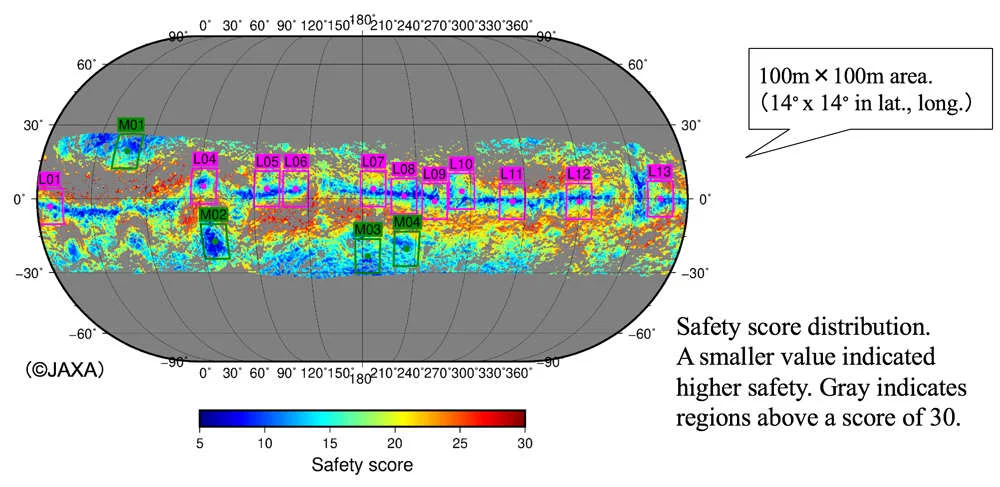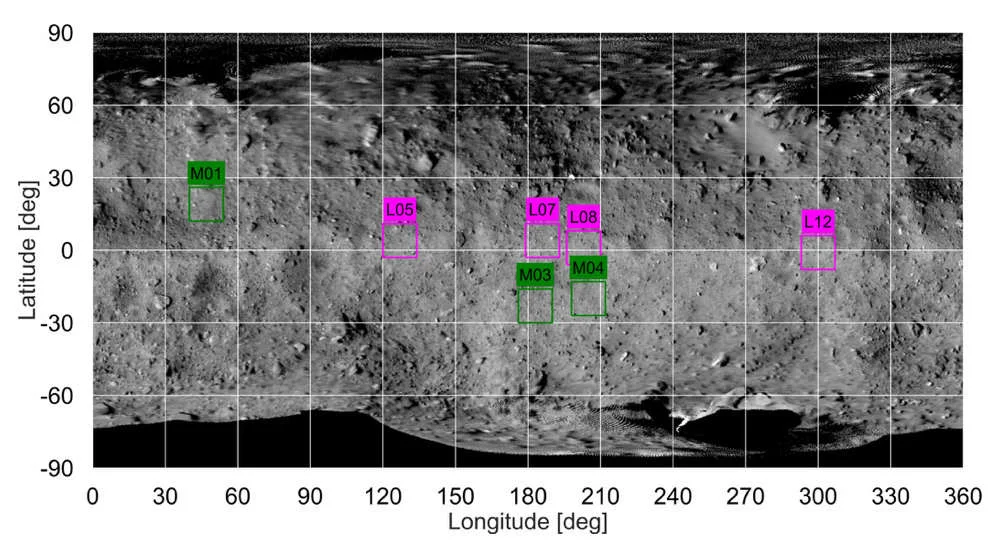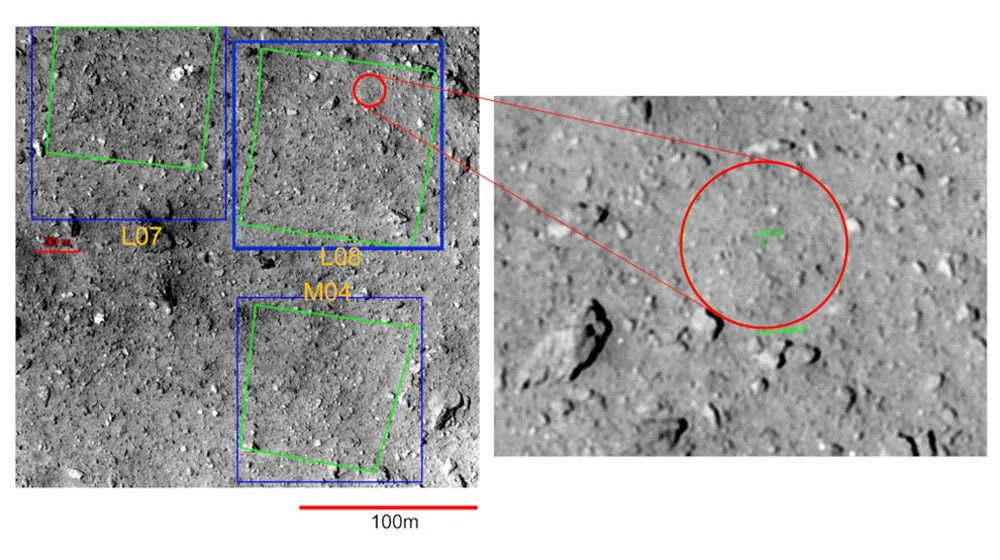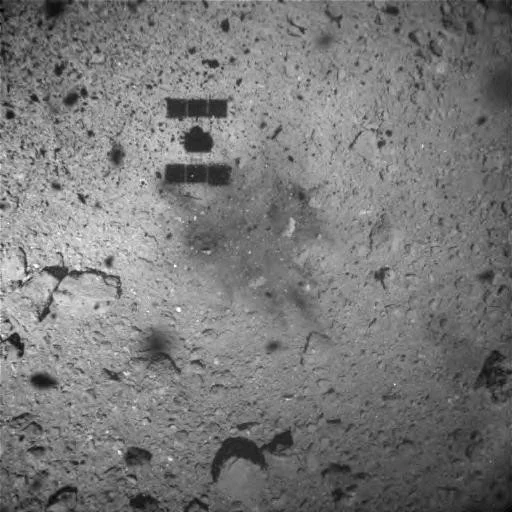Ryugu's Visitor
The touchdown zone after Hayabusa2 departed Ryugu’s surface. The dark central area was discolored from Hayabusa2’s thrusters or the impact bullet used to eject surface material. The sun is behind the spacecraft, therefore, Hayabusa2’s shadow is clearly visible on the surface. Credit: JAXA, University of Tokyo, Kochi University, Rikkyo University, Nagoya University, Chiba Institute of Technology, Meiji University, University of Aizu, AIST.
The quiet, everlasting vacuum has been a steady companion. After millions of years, a new visitor emerged from the darkness. Normally visitors come barreling in and cause a significant disturbance. Unusually, this visitor remained in a cautious orbit for a few months. Out of nowhere, this new companion approached with a strange appendage and fired a metal slug into the surface. Materials ejected were collected in a surgical fashion before the visitor retreated back to a safe distance. Quietness once again enveloped the scene.
This is the story of the near-Earth asteroid (NEA) Ryugu and the Japanese Aerospace Exploration Agency (JAXA) Hayabusa2 spacecraft. Hayabusa2 was launched in December 2014 and spent three and a half years in transit to Ryugu. Hayabusa2 will study Ryugu for a year and a half, leaving in December 2019 for a one year return trip to Earth.
Since arriving at Ryugu in June 2018, Hayabusa2 has surveyed Ryugu and deployed three of its surface rovers: Rover-1A (HIBOU), Rover-1B (OWL), and MASCOT. All rovers collect in-situ observations of Ryugu’s surface regolith. They are able to hop around the surface due to Ryugu’s very low gravity. Both HIBOU and OWL were deployed from the MINERVA-II container. MASCOT survived for 16 hours before it’s non-rechargeable battery died, while HIBOU and OWL continue to collect observations due to their solar panels.
Hayabusa2’s defining feature is its ability to sample regolith and return the samples to Earth. It performed the first sample collection process on 21 February 2019. Initial reports show that the sampler touched the surface and performed the required collection process. However, we do not yet know how much material was collected.
The descent profile Hayabusa2 followed when performing its first surface collection process. Starting from a 20 km orbit, Hayabusa2 descended towards the surface of Ryugu. After slowing the descent around 5 km, Hayabusa2 verified the collection process was good to go around 45 m above the surface. The collection process took only a few seconds before ascending back towards a safe orbit. Credit: JAXA.
The collection process required Hayabusa2 to descend from its 20 km orbit to the surface of Ryugu. With all systems good, Hayabusa2’s 100 cm sampler horn touched down within 3 m (9.8 ft) of the target location.
A 5 gram tantalum bullet was then fired into the regolith at 300 m/s (984 ft/s). Tantalum is a hard, blue-gray metal that was used because of its chemical inertness. It is imperative to not contaminate the material collected at Ryugu before proper study.
The bullet impact caused the surface material to eject and move into one of the three sampler containers. Only 0.1 grams is required per sampling success, however, each sampling container can store up to 10 grams. The entire sampling process takes a few seconds. Soon after, Hayabusa2 departed the surface and returned to a safe orbit.
An important requirement for selecting the sample collection area was based on Hayabusa2 being in sight of Earth and having its solar panels in sunlight. This restricted the site to areas within 30 degrees of Ryugu’s equator, and at sites with inclines less than 30 degrees. Credit: JAXA.
The target sampling site was carefully selected after extensive analysis. The first requirement included Hayabusa2’s top to always be less than 30 degrees from the direction of the Earth and Sun. This was to ensure that Hayabusa2 could maintain a consistent communication link to Earth and that its solar panels were pointed towards the Sun throughout the operation. This restricted the target zone to within a 30 degree latitude from the equator and having a surface slope less than 30 degrees.
The next requirement included having a flat region about 100 m (328 ft) in diameter. This gives Hayabusa2’s guidance system a buffer area for touchdown. Initially, the guidance accuracy was a radius of about 50 m, however, this was later narrowed down to 6 m. No flat areas larger than 30 m across were identified, thus the team updated their landing technique to fit the situation.
The target area needed to not have any boulder larger than 50 cm in height. Since the sampler horn was about 100 cm in length, it was important to allow it to contact the surface without Hayabusa2’s body contacting a boulder.
Lastly, the target surface needed to have a surface temperature less than 97 C (206 F). This limit would prevent Hayabusa2 from becoming overheating when performing the sampling activity. Regolith has the potential to reflect harmful heat from the Sun onto nearby spacecraft.
The Hayabusa2 team performed a safely analysis with these constraints, and narrowed down the results from an asteroid wide area to a single 12 m wide area.
The surface rovers showed that the surface of Ryugu contained cm-sized and larger boulders and no fine regolith. This was unexpected and required the Hayabusa2 team to delay their initial October 2018 sampling process until they testing their sampling system on coarser material. The Earth based results (see embedded Twitter video) indicated their system would still work, giving the team confidence that their latest sampling process would succeed.
The results of the recent sampling process are still being evaluated. Based on the results, the team will determine if they need to alter the process for the next sampling attempt. Hayabusa2 still has two more sampling attempts. The next sample will also be of the surface material, but in a different area on Ryugu.
The final sampling attempt will be of a subsurface area. Hayabusa2 will soon deploy the Small Carry-on Impactor (SCI), which will shoot a 2.5 kg (5.5 lb) copper projectile into Ryugu. This is expected to create a crater 2 m in diameter, exposing pristine material. Hayabusa2 will wait two weeks after the impact before sampling the freshly exposed material. This is currently planned for December 2019.
Since Ryugu is a carbonaceous asteroid, let us hope they identify plentiful hydrated materials in their samples. This would bode well for future asteroid processing missions. After a long journey, Hayabusa2’s samples are expected to arrive on Earth in December 2020. This sample and return mission is a highly valued research mission that is expanding our understanding of our nearby celestial neighbors.
References
http://www.hayabusa2.jaxa.jp/en/topics/20190220e_TDPoint
http://www.hayabusa2.jaxa.jp/en/topics/20190221e_TD1-L08E1_Schedule/
https://eos.org/articles/asteroid-mission-attempts-touchdown-sample-grab














